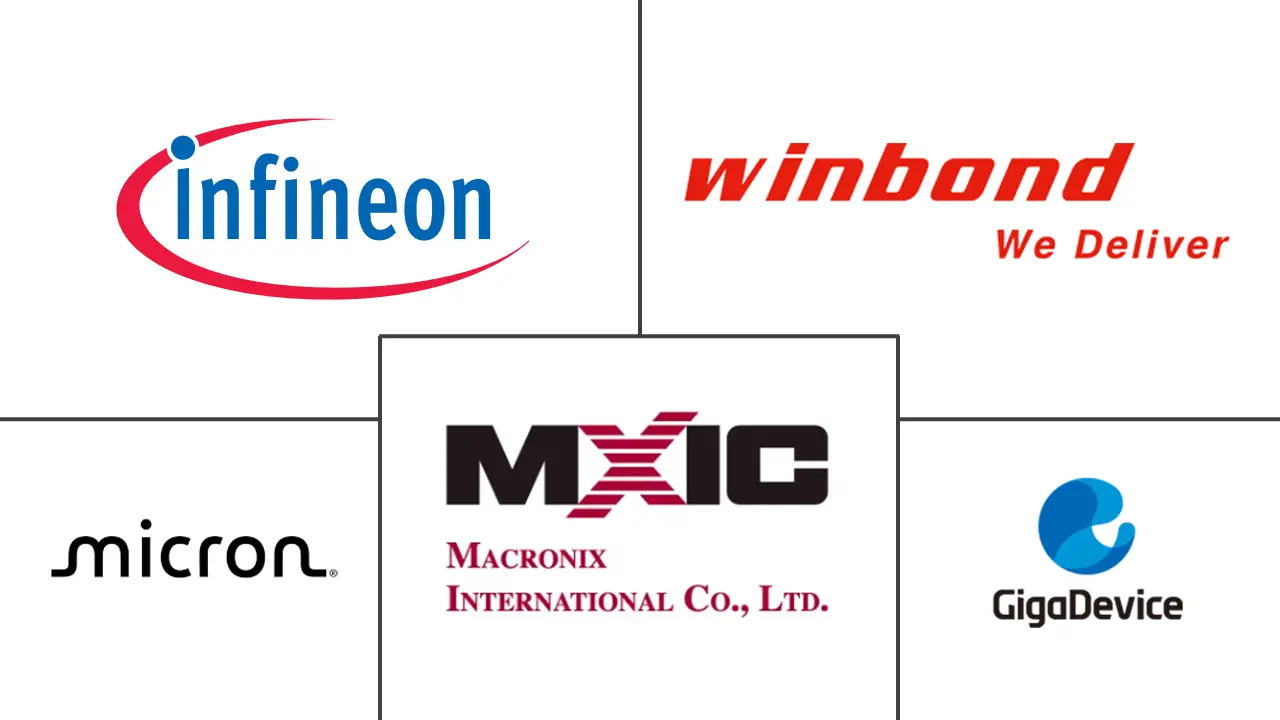NOR Flash For Consumer Electronics Market Size and Share
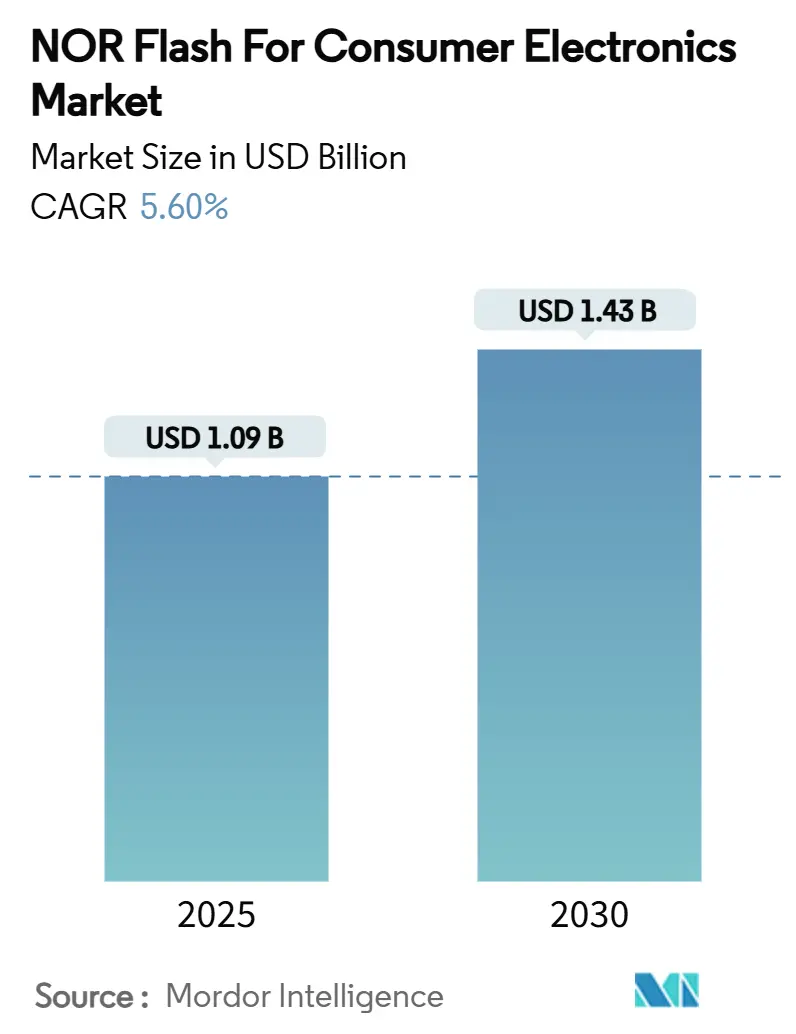
NOR Flash For Consumer Electronics Market Analysis by Mordor Intelligence
The consumer electronics NOR flash market size stands at USD 1.09 billion in 2025 and is forecast to reach USD 1.43 billion by 2030, advancing at a 5.6% CAGR. A steady topline hides decisive shifts in architecture as device makers pursue instant-on performance, stringent power budgets, and hardening against firmware attacks. Octal and xSPI interfaces are moving quickly into high-volume production, driving bandwidth that supports always-listening gadgets, 4K imaging, and low-latency edge inference workloads. Others (less than 1.8 V, 2.5 V, 5 V…) parts are displacing 3 V devices in wearables, while high-density (greater than 256 Mb) serial parts now underpin execute-in-place (XiP) code stores for consumer edge-AI appliances. Meanwhile, widening Chinese capacity at 55/40 nm nodes is compressing ASPs and reshaping the cost curve for mid-density serial NOR.
Key Report Takeaways
- By type, Serial NOR commanded 78.1% revenue share in 2024, while Parallel NOR declined.
- By interface, Quad SPI held 52.2% revenue share in 2024; Octal and xSPI are projected to expand at a 5.9% CAGR through 2030.
- By density, 32-64 Mb captured 29.2% of the consumer electronics NOR flash market share in 2024; the greater than 256 Mb tier is forecast to advance at a 5.7% CAGR to 2030.
- By voltage, the 1.8 V class accounted for 47.5% share of the consumer electronics NOR flash market size in 2024, while Sub-1.8 V parts are growing at a 5.6% CAGR.
- By process node, 55 nm accounted for 39.2% revenue in 2025; 28 nm and below is the fastest-growing node at 5.8% CAGR.
- By packaging, QFN/SOIC accounted for 50.7% revenue in 2025; WLCSP/CSP is the fastest-growing node at 5.7% CAGR.
- By geography, Asia Pacific dominated with a 56.7% share in 2024. Asia Pacific also records the fastest projected CAGR at 6.5% through 2030.
Global NOR Flash For Consumer Electronics Market Trends and Insights
Drivers Impact Analysis
| Driver | (~) % Impact on CAGR Forecast | Geographic Relevance | Impact Timeline |
|---|---|---|---|
| Voice-first smart-home hubs need instant-on firmware | +1.2% | North America, Europe, Urban Asia Pacific | Medium term (2-4 years) |
| Ultra-low-power wearables (≤1.8 V serial) push sub-45 nm demand | +1.5% | Global; early adoption in North America and China | Medium term (2-4 years) |
| Secure-boot and OTA mandates in TVs and consoles | +0.8% | North America, Europe, Japan, South Korea | Short term (≤2 years) |
| China 55/40 nm localization boosts mid-density NOR in smartphones | +0.7% | China; spillover to Southeast Asia | Short term (≤2 years) |
| Quad/Octal SPI enable 4K camera and drone fast-boot | +0.9% | Global; strongest in North America and China | Medium term (2-4 years) |
| Edge-AI IoT appliances adopt XiP on high-density serial NOR | +1.1% | North America, Europe, Japan, South Korea, Urban China | Long term (≥4 years) |
| Source: Mordor Intelligence | |||
Proliferation of Voice-First Smart-Home Hubs Requiring Instant-On Firmware
Mass-market smart‐speaker refresh cycles now set boot-time targets below 100 ms. Quad and Octal SPI throughput meets that demand, while the Matter protocol increases code size for secure interoperability. A 2024 redesign by a leading smart-speaker maker raised NOR capacity 24% without enlarging the PCB, underlining the link between richer firmware and serial NOR density. Execute-in-place (XiP) further limits DRAM use, pushing sustained reads directly from flash and raising interface bandwidth needs.
Ultra-Low-Power Wearables (≤1.8 V Serial NOR) Driving Sub-45 nm Demand
Battery-powered trackers and earbuds adopt 1.2 V serial NOR that cuts active power by one-third. Macronix MX25S parts achieve up to 63% savings versus 3 V devices, extending wearable uptime from 5 days to 8 days in a 2024 flagship fitness band[1]Macronix International Co., Lp. "Low Power Architectures Thrive in Emerging Markets." Accessed April 17, 2025. . Process migration toward 28 nm enables deep-sleep currents below 7 nA, opening room for always-listening modes within smartwatch power envelopes.
Secure-Boot and OTA-Update Mandates in Connected TVs and Gaming Consoles
Regulations and consumer trust push OEMs to protect firmware images. Winbond’s TrustME® secure flash stores encryption keys and boot code separately from main storage, delivering 4 MB capacity at lower cost than discrete secure-element ICs[2]Tasher, Nir. "A new architecture for the provision of secure storage offers higher capacity at lower cost." Winbond Technology Ltd. Accessed April 17, 2025. . A 2024 console launch showcased layered authentication using dedicated NOR, blocking unsigned updates and shrinking warranty returns tied to tampering.
China's 55/40 nm Localization Push Boosting Mid-Density NOR for Smartphones
Domestic suppliers such as GigaDevice increased output 25% year-on-year in 2024 to meet mainland handset demand and captured 18% market share[3]GigaDevice Semiconductor (Beijing) Inc. "Mission Statement, Vision, & Core Values (2025) of GigaDevice Semiconductor." DCF Modeling. Accessed April 17, 2025. . One top Chinese OEM shifted 80% of mid-range phone NOR sourcing to local fabs, reducing BOM cost 12% and lowering logistics risk.
Restraints Impact Analysis
| Restraint | (~) % Impact on CAGR Forecast | Geographic Relevance | Impact Timeline |
|---|---|---|---|
| Cost premium vs. NAND >256 Mb limits hi-res camera adoption | -0.7% | Global | Medium term (2-4 years) |
| Scaling ceilings >45 nm steer OEMs to MRAM/ReRAM | -0.5% | North America, Europe, Japan, South Korea | Long term (≥4 years) |
| ASP compression from rising Chinese capacity | -0.9% | Global; strongest in Asia Pacific | Short term (≤2 years) |
| Foundry concentration in Taiwan poses supply risk | -0.3% | Global | Medium term (2-4 years) |
| Source: Mordor Intelligence | |||
Cost Premium vs NAND >256 Mb Limiting Hi-Resolution Camera Adoption
Above 256 Mb, NAND retains a 30-40% cost advantage. Winbond’s OctalNAND provides 1-4 Gb densities at NOR-class read speeds, lowering storage cost for 8K action cameras by 38% in a 2024 product refresh. Hybrid controller schemes that pair Octal interfaces with NAND help preserve boot speed, further narrowing NOR’s niche at ultra-high densities.
Scaling Ceilings more than 45 nm Steering OEMs Toward MRAM/ReRAM Alternatives
NOR’s tunnel-oxide design becomes unreliable below 28 nm, whereas ReRAM scales to 22 nm with better endurance. Synopsys IP libraries added ReRAM macro options for 22 nm ASIC tape-outs in late 2024, offering embedded non-volatile storage without charge-trap limitations. Edge-AI silicon adopting these nodes may bypass NOR entirely for program storage.
Segment Analysis
By NOR Flash Type: Serial NOR Dominates Despite Parallel Resurgence
Serial NOR captured 78.1% of the consumer electronics NOR flash market in 2024, reflecting its four-pin interface, small footprint, and low active power. The segment benefits from XiP support that allows MCUs to run code directly from external flash, cutting DRAM size. Parallel NOR, although relegated to a 21.9% share, grows at a 2.4% CAGR as gaming consoles and premium TVs seek maximum read bandwidth for large operating systems.
Serial’s ascendancy is reinforced by Quad and Octal SPI extensions that rival parallel throughput while retaining a slim pin count. Macronix’s early samples of 3D NOR promise up to 8× density increase within the serial ecosystem. As a result, serial formats are likely to encroach further on performance niches once reserved for parallel parts.
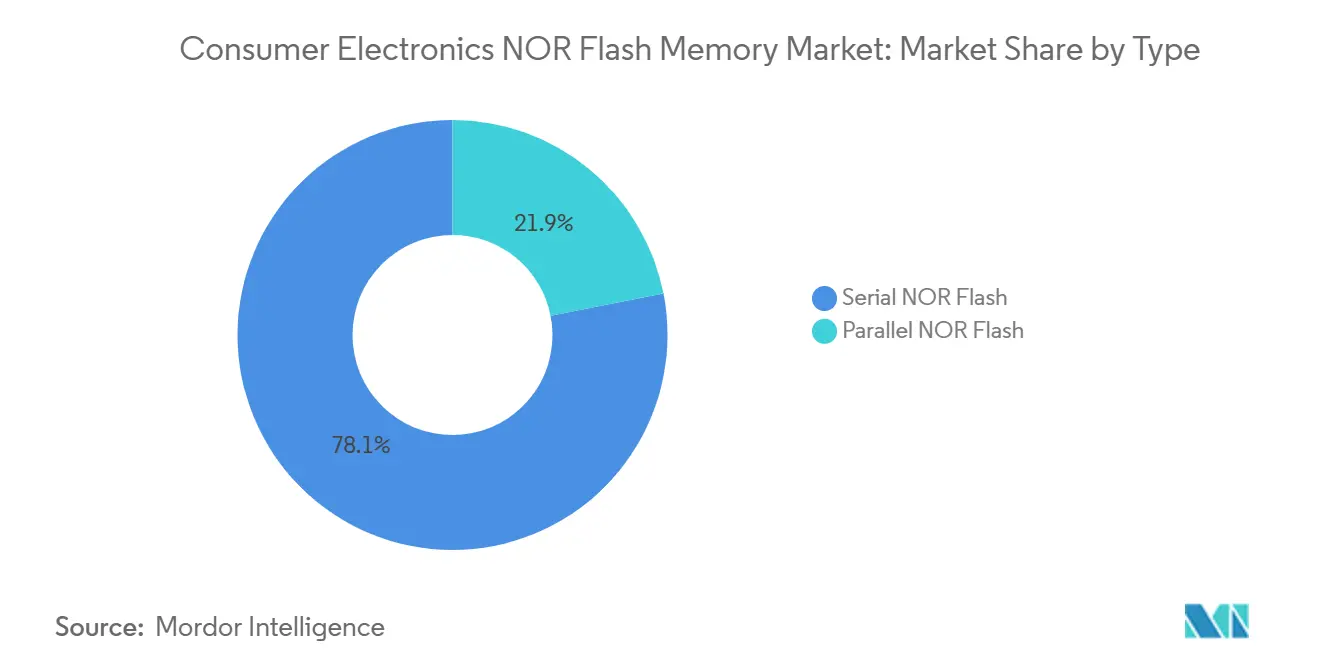
Note: Segment shares of all individual segments available upon report purchase
By Interface: Octal and xSPI Accelerate Performance Curve
Quad SPI secured 52.2% interface share in 2024, offering a cost-effective uplift over legacy single-wire SPI. Octal and xSPI hold 5.9% yet rise swiftly, pushed by boot-time targets under 2s for smart TVs. A premium TV maker cut boot-to-home time from 4.2s to 1.8s after an Octal upgrade, confirming payback via user-experience metrics.
xSPI, standardized at 400 MB/s, is set to eclipse proprietary variations, ensuring controller interoperability and lowering design risk. At the budget end, single/dual SPI remains entrenched in ultra-low-power sensors that prioritize microamp sleep currents over speed.
By Density: 32-64 Mb Sweet Spot Faces High-Density Challenge
Devices in the 32-64 Mb band accounted for 29.2% of market revenue in 2024, balancing price and firmware headroom for mainstream smartphones. However, greater than 256 Mb serial parts advance at a 5.7% CAGR, enabled by edge-AI routines and local voice recognition. A smart speaker upgraded to 256 Mb flash in 2024, shaving 78% latency by eliminating cloud queries.
Lower tiers at 2-8 Mb persist in Bluetooth trackers and simple remotes, where code is sparse. NAND competition intensifies beyond 512 Mb, but NOR maintains relevance where random read and byte-programmability outweigh cost-per-bit metrics.

Note: Segment shares of all individual segments available upon report purchase
By Voltage: Others (Less Than 1.8 V, 2.5 V, 5 V…) Class Drives Battery-Powered Innovation
The 1.8V class held 47.5% share in 2024, meeting mobile SoC I/O rails. Others (less than 1.8V, 2.5V, 5V…) serial flash is the fastest mover at 5.6% CAGR, slashing converter losses in wearables. Winbond’s 1.2V family removes PMIC overhead and lowers carbon footprint 34% in earbud reference designs [4]Winbond Electronics Corporation. "Winbond's new OctalNAND Flash provides fast, low-cost alternative to Octal NOR Flash." DIGITIMES. Accessed April 17, 2025. .
Wide-voltage (1.65–3.6V) parts give design flexibility for brown-out-tolerant gadgets, while legacy 3V devices stay relevant in set-top boxes with relaxed energy budgets.
By Process Technology Node: 55 nm Dominance Challenged by Advanced Nodes
Production at 55 nm represented 39.2% of the consumer electronics NOR flash market size in 2024, winning on die cost and mature yields. China’s localization focuses here, with SMIC expanding 55/40 nm lines for domestic customers.
Nevertheless, 28 nm and below grow 5.8% CAGR as sub-1.2 V products require tighter geometries. Diminishing cell margins complicate reliability, so suppliers invest in error-correct logic and proprietary charge-trap tweaks to sustain endurance.

Note: Segment shares of all individual segments available upon report purchase
By Packaging Type: QFN/SOIC Mainstream Faces WLCSP Challenge
QFN and SOIC held 50.7% shipment share in 2024, favored for low cost and automated surface-mount flow. Wafer-level CSP advances at 5.7% CAGR, enabling 1 mm-thin wearables by eliminating package substrate height. A tracker OEM reduced device thickness 1.2 mm via WLCSP adoption, freeing space for a 15% bigger battery.
FBGA remains crucial in consoles demanding high pin counts, while stacked-die SiP is gaining popularity for camera modules that co-locate NOR and sensor processors in confined z-height envelopes.
Geography Analysis
Asia Pacific led with 56.7% of the consumer electronics NOR flash market in 2024, anchored by China’s manufacturing base and 55 nm capacity build-out. Domestic phone brands cut NOR procurement costs by 12% after pivoting to local supply, highlighting policy-driven competitiveness. Taiwan’s foundry cluster underpins global output yet concentrates geopolitical and seismic risk, prompting OEMs to dual-source from mainland plants where feasible. The region is also anticipated to remain the fastest growing during the forecast period, growing at a CAGR of about 6.5%.
North America's growth is also anticipated to gain traction, driven by the recent push into the semiconductor and electronics manufacturing industry. Growing demand for consumer electronics also supports this growth. Premium smart-home hubs and edge-AI appliances require high-security flash; one Silicon Valley vendor migrated its range to encrypted serial NOR in 2025. Federal incentives are reviving domestic memory fabs: Micron’s USD 6.1 billion CHIPS Act grant will expand Idaho and New York capacity for advanced nodes.
Europe remains stable, valuing ten-year data retention and stringent privacy compliance. A German home-automation firm pays a 15% cost premium for industrial-grade NOR to guarantee reliability. The European Chips Act aims to lift regional self-sufficiency, easing import reliance. Latin America and the Middle East round out the rest of the world, where rising disposable income fuels the adoption of smartphones and smart TVs that embed mid-density serial NOR.
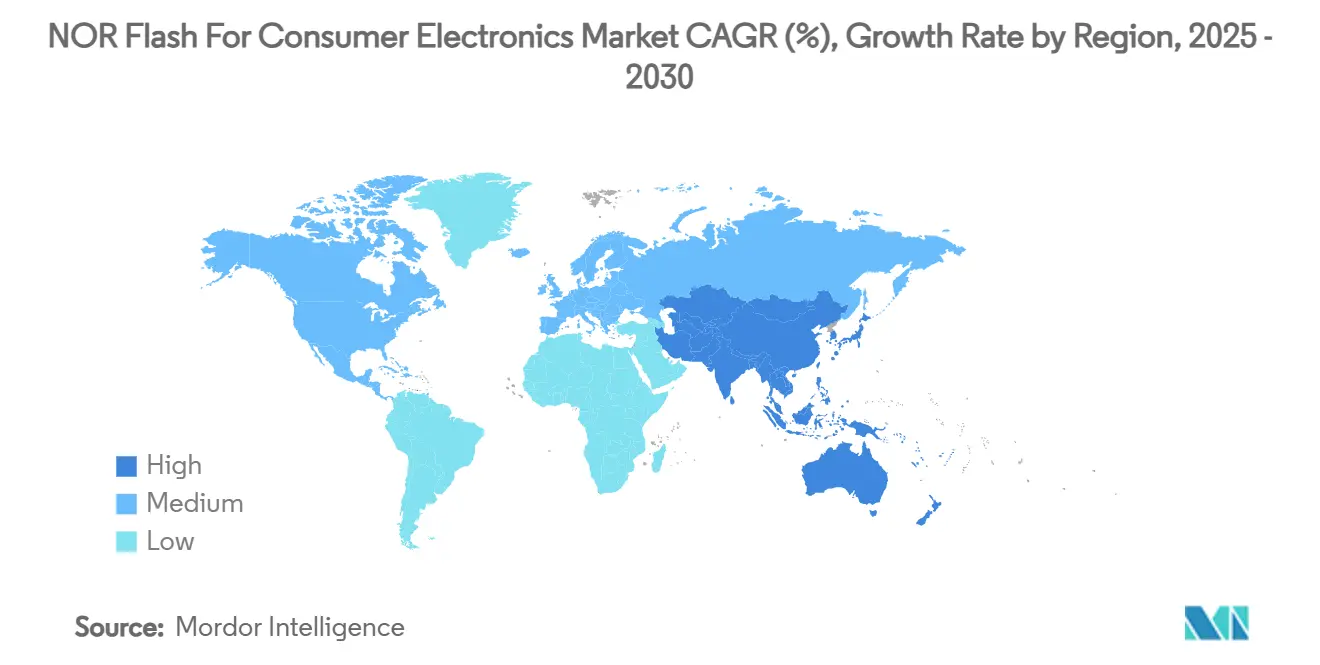
Competitive Landscape
The consumer electronics NOR Flash market is moderately concentrated. Tier-one suppliers, Winbond, Macronix, and GigaDevice, span densities from 4 Mb to 2 Gb and integrate wafer fabrication with packaging. Their scale lets them absorb ASP erosion triggered by China’s 20% capacity hike in 2024, which sliced average prices 15% within six months. Tier-two firms like Cypress (Infineon) focus on automotive-grade QSPI, while Kioxia pursues stacked-die mobile combos.
Differentiation now orbits security blocks, ultra-low-power design, and high-speed interfaces rather than the lowest bit cost. Winbond’s 1.2 V line and Macronix 3D NOR roadmap exemplify a feature-led strategy. Meanwhile, MRAM/ReRAM entrants such as Weebit Nano secured AEC-Q100 150 °C qualification in March 2025, signaling credible alternatives for nodes below 28 nm.
Regulatory incentives reshape the field, e.g., US CHIPS funding boosts Micron, while China’s Made-in-China 2025 underwrites domestic volumes. IP vendors like Synopsys monetize the transition by licensing xSPI PHYs and controllers that cut time-to-market for SoC designers targeting high-speed serial flash. White-space opportunities persist in secure IoT endpoints where performance trumps cents-per-bit calculations.
NOR Flash For Consumer Electronics Industry Leaders
-
Winbond Electronics Corporation
-
Macronix International Co. Ltd.
-
GigaDevice Semiconductor Inc.
-
Micron Technology Inc.
-
Infineon Technologies AG
- *Disclaimer: Major Players sorted in no particular order
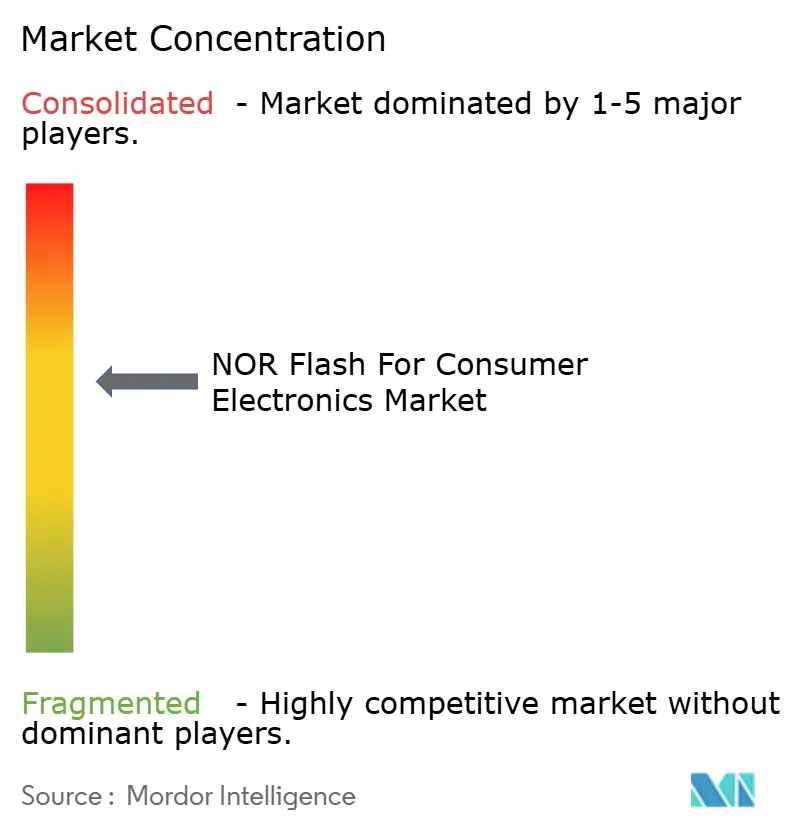
Recent Industry Developments
- May 2025: Macronix began sampling 3D NOR flash chips, promising 8× density and lower power versus 2D NOR.
- April 2025: Micron secured USD 6.1 billion in CHIPS Act support toward a USD 50 billion memory fab expansion in Idaho and New York.
- March 2025: Weebit Nano ReRAM achieved AEC-Q100 150 °C qualification, meeting automotive reliability standards.
- February 2025: Winbond rolled out 128 Mb and 256 Mb 1.2 V NOR for wearables, cutting active power by 33%.
Research Methodology Framework and Report Scope
Market Definitions and Key Coverage
Our study defines the consumer-electronics NOR flash memory market as the yearly revenue derived from newly manufactured serial and parallel NOR chips that finally sit inside smartphones, tablets, digital cameras, smart TVs, wearables, and smart-home devices where quick byte-level code execution is critical. According to Mordor Intelligence, we count only original component sales that move straight to device makers or their EMS partners, and we remove reseller mark-ups.
Scope Exclusion: Shipments bound for automotive, industrial, communication, or defense hardware and every NAND or emerging non-volatile memory lie outside this assessment.
Segmentation Overview
- By Type (Value and Volume)
- Serial NOR Flash
- Parallel NOR Flash
- By Interface (Value)
- SPI Single / Dual
- Quad SPI
- Octal and xSPI
- By Density (Value)
- 2 Megabit And Less NOR
- 4 Megabit And Less-NOR (greater than 2mb) NOR
- 8 Megabit And Less (greater than 4mb) NOR
- 16 Megabit And Less (greater than 8mb) NOR
- 32 Megabit And Less (greater than 16mb) NOR
- 64 Megabit And Less (greater than 32mb) NOR
- 128 Megabit and Less (greater than 64MB) NOR
- 256 Megabit and Less (greater than 128MB) NOR
- Greater than 256 Megabit
- By Voltage (Value)
- 3 V Class
- 1.8 V Class
- Wide-Voltage (1.65 V - 3.6 V)
- Others (<1.8 V, 2.5 V, 5 V…)
- By Process Technology Node (Value)
- 90 nm and Older
- 65 nm
- 55 nm (incl. 58 nm)
- 45 nm
- 28 nm and Below
- By Packaging Type (Value)
- WLCSP / CSP
- QFN / SOIC
- BGA / FBGA
- Others
- By Geography (Value and Volume)
- North America
- United States
- Canada
- Mexico
- Europe
- Germany
- France
- United Kingdom
- Italy
- Rest of Europe
- Asia Pacific
- China
- Japan
- South Korea
- Taiwan
- India
- South East Asia
- Rest of Asia Pacific
- Rest of the World
- North America
Detailed Research Methodology and Data Validation
Primary Research
Mordor analysts then interviewed NOR design engineers, EMS buyers, and firmware architects across Asia-Pacific, North America, and Europe. Their insights refined attach-rate, average density, and interface-mix assumptions that desk work could only approximate.
Desk Research
Our team first pulled volume signals from MIIT handset output, IDC wearable trackers, and UN Comtrade tariff codes 854232 and 854233. Price corridors were shaped through Form 10-K revenue splits, JEDEC and SIA statistical notes, plus proprietary looks on D&B Hoovers and Dow Jones Factiva that link vendor revenue to regional flow. The sources cited are illustrative; many other public and subscription materials were reviewed to cross-check and clarify findings.
Market-Sizing & Forecasting
Our top-down model converts yearly output of each device group into a NOR-addressable pool by applying penetration and density coefficients drawn from interviews and teardown logs. Supplier roll-ups, channel checks, and sampled average selling prices validate totals. Core variables such as global smartphone shipments, smartwatch volumes, the SPI to xSPI transition, die-shrink curves, and average NOR density per device feed a multivariate regression that carries the forecast through 2030, while scenario analysis cushions demand shocks.
Data Validation & Update Cycle
We run variance scans against customs data and vendor disclosures, conduct multi-step peer reviews, and sign off only after anomalies clear. Reports refresh once a year, with interim updates triggered when quarterly shipments swing beyond five percent or when a material technology inflection occurs.
Why Mordor's NOR Flash For Consumer Electronics Baseline Commands Reliability
We know published estimates often diverge because some firms bundle extra end-users, lock exchange rates, or lean solely on supplier revenue. Mordor's disciplined segmentation, annual refresh, and dual-source verification anchor a balanced baseline that users can trace back to clear device counts.
These contrasts show how our tighter scope, constant validation, and timely refresh give clients a dependable reference for strategy and planning.
Benchmark comparison
| Market Size | Anonymized source | Primary gap driver |
|---|---|---|
| USD 1.09 B | Mordor Intelligence | - |
| USD 5.27 B | Regional Consultancy A | Combines automotive and industrial demand, mixes NAND revenue, minimal primary checks |
| USD 2.85 B | Global Consultancy B | Uses manufacturer revenue only, 2023 FX rates, refreshes every two years |
These contrasts show how our tighter scope, constant validation, and timely refresh give clients a dependable reference for strategy and planning.
Key Questions Answered in the Report
What is driving growth in the consumer electronics NOR flash market?
Growth stems from instant-on requirements, adoption of Octal/xSPI interfaces, Others (<1.8 V, 2.5 V, 5 V…) ultra-low-power designs and edge-AI appliances that need high-density serial NOR.
Why are Octal and xSPI interfaces gaining traction?
They deliver up to 400 MB/s throughput, cutting boot times for smart TVs, drones and 4K cameras, and they maintain the small footprint of serial flash packages.
How does China’s localization policy affect global supply?
Expanded 55 nm capacity lowers ASPs industry-wide and shifts sourcing toward domestic vendors, reducing dependence on overseas suppliers for mid-density serial NOR.
Are alternative memories a threat to NOR flash?
MRAM and ReRAM gain share in nodes below 28 nm where NOR scaling falters, but NOR remains competitive in mainstream consumer devices requiring execute-in-place code storage.
Page last updated on:
